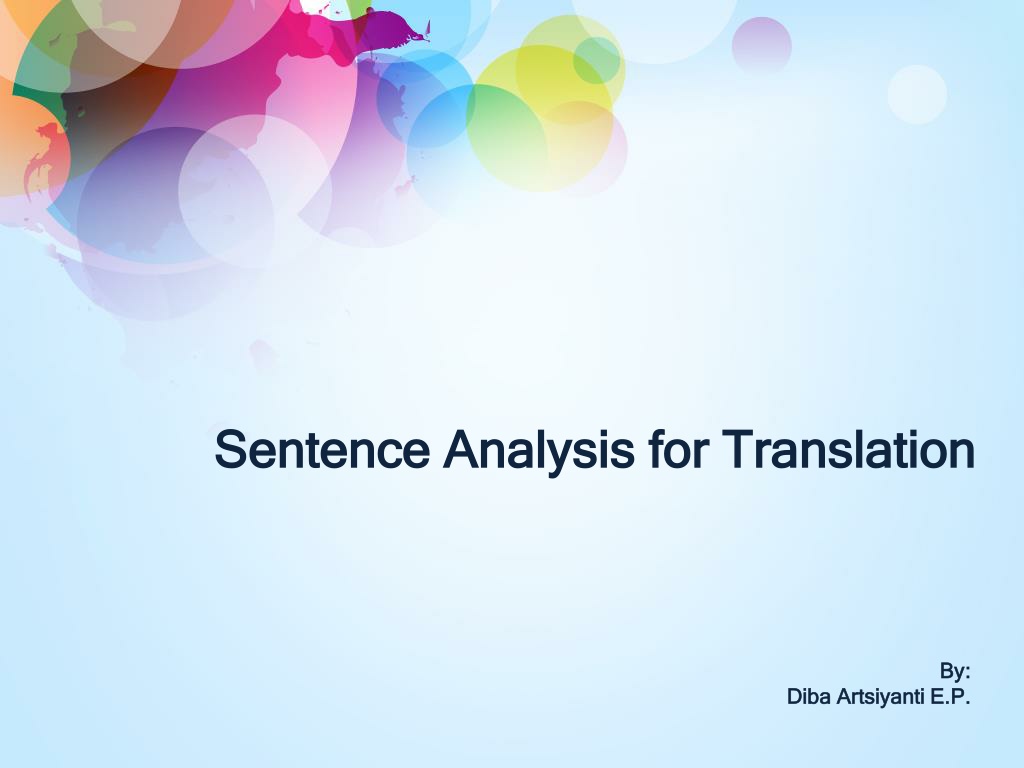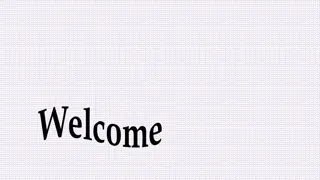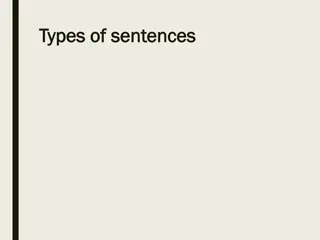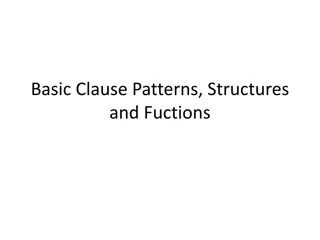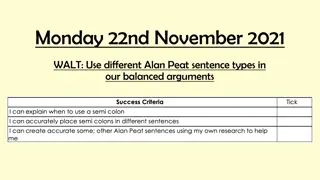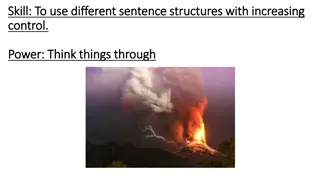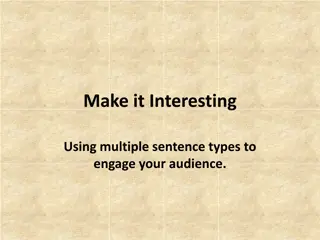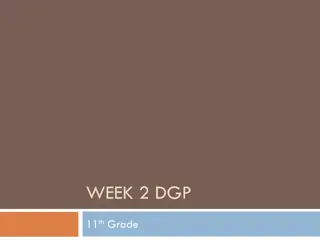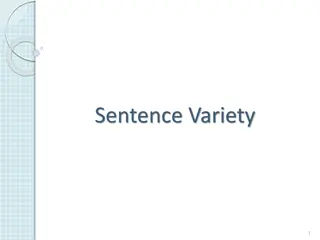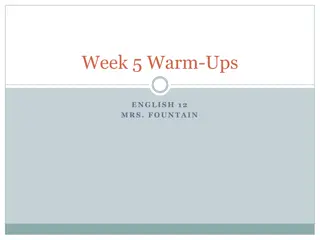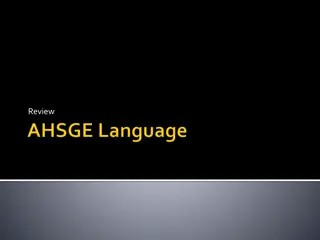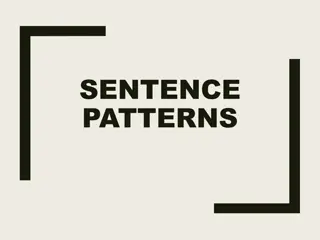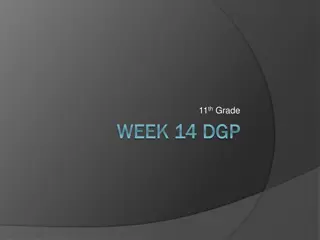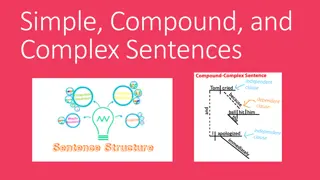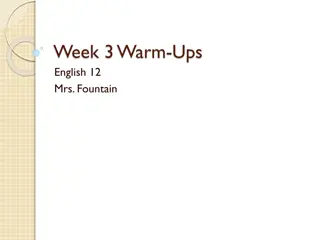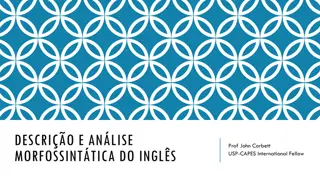Sentence Components and Structures
Unravel the essentials of sentence analysis for accurate translation. Explore simple sentences, subjects, verbs, and objects, along with parts of speech, compound and complex sentences, and the significance of clauses in constructing sentences effectively.
Download Presentation

Please find below an Image/Link to download the presentation.
The content on the website is provided AS IS for your information and personal use only. It may not be sold, licensed, or shared on other websites without obtaining consent from the author.If you encounter any issues during the download, it is possible that the publisher has removed the file from their server.
You are allowed to download the files provided on this website for personal or commercial use, subject to the condition that they are used lawfully. All files are the property of their respective owners.
The content on the website is provided AS IS for your information and personal use only. It may not be sold, licensed, or shared on other websites without obtaining consent from the author.
E N D
Presentation Transcript
Sentence Analysis for Translation Sentence Analysis for Translation By: By: Diba Artsiyanti E.P Diba Artsiyanti E.P. .
Simple Sentence A simple sentence is one independent clause. In written form, it starts with a capital letter and ends with period. should consist at least one subject and one verb (or to be + adjective/noun) S + V + O + C Example: The patient visited the clinic yesterday She is a doctor
Subjects, Verbs, and Objects Subject who or what did something noun or pronoun, including noun phrase Verb cannot be used as a subject gerund Verb tells an action or links the subject with the rest of the sentence Action verb: run, write, look Linking verbs: to be, become, look, feel, seem, smell, sound, and taste Object not all sentences have objects affected by verbs Direct object Indirect object Example: She gave me the book. Complement complete the sentence Example: She gave me the book yesterday
Parts of speech Nouns name a person, place, or things (dog, tree, book, etc) Pronouns take the place of a noun (he, she, it, John, Mary, etc) Verbs express actions or link to other parts of sentence (see, look, hear, etc) Adjectives describe a noun of pronoun (slow, big, round, etc) Adverbs describe a verb, an adjective, or another adverb (slowly, desperately, etc) Prepositions placed before a noun or pronoun to create a phrase that relates to other parts of the sentence (in, on, at, to) Conjunctions Join words or other sentence elements show relationship (and, but, since, if, etc) later described as coordinators, conjunctive adverbs, and subordinators Interjection show surprise or emotion (wow, hey, etc)
Compound and Complex Compound and Complex Sentences Sentences
Clause Clause -Building blocks of a sentence at least consist of a subject and a verb -Used for creating compound, complex, and compound complex sentences
Clause Clause ( (cont. cont.) ) Types of clause: Independent : S + Verb/to be + (complement) Examples: Water evaporates rapidly in warm climate zones He ran away Dependent: (subordinator) + S + Verb/to be+ (complement) Examples: .....when the patient visited the clinic .....after the blood sample was subjected to the test
Compound Sentence A compound sentence is two or more independent clauses joined together using: A coordinator: Salt water boils at a higher temperature than freshwater, so so food cooks faster in salt water A conjunctive adverb: Salt water boils at a higher temperatur than freshwater; therefore therefore, food cooks faster in salt water. A semicolon: only when the two independent clauses are closely related in meaning Salt water boils at a higher temperature than freshwater; ; food cooks faster in salt water
Coordinators Coordinator Coordinator For And Nor But Or Yet So Function Function To add a reason To add a similar, equal idea To add a negative equal idea To add an opposite idea To add an alternative possibility To add an unexpected or surprising continuation To add an expected result
Conjunctive adverbs Function Function To add a similar, equal idea Conjuctive adverb Conjuctive adverb also, besides, furthermore, in addition, moreover, as well, too however, nevertheless, nonetheless, still To add an unexpected or surprising continuation To add a complete contrast To give an alternative possibility otherwise To add an expected result on the other hand, in contrast, on the contrary accordingly, as a result, consequently, hence, therefore, thus for example, for instance To add an example
Exercise The patient wanted to see the doctor The patient experienced pain in the stomach
Exercise Her condition improved yesterday She died this morning
Complex Sentence A complex sentence contains one independent clause and one (or more) dependent clause: Examples: A citizen can vote in Indonesia when he or she is 17 years old Men who are not married are called bachelors The doctor wanted to know what illness is suffered by the patient The film Lawrence of Arabia is three hours and forty-one minutes long, one minute longer than Gone with the Wind is.
List of some subordinators After After Although Although As, just as As, just as As if As if As soon as As soon as Because Because Before Before Even though Even though How How If If Since Since So that So that That That Though Though Unless Unless Until Until What What When When Whenever Whenever Wherever Wherever Whether Whether Which Which While While Who Who whom whom
Exercise I need to see the doctor The doctor is sitting there
Compound Complex Sentence A compound-complex sentence has at least three clauses with at least two are independent clauses Example: I wanted to travel after I graduated from college, but I had to go to work immediately because I had to support my family.
Exercise The Court has noted the Government s submissions concerning its strongly held conviction that zg r G ndem and its staff supported the PKK and acted as its propaganda tool. This does not, even if true, provide a justification for failing to take steps effectively to investigate and, where necessary, provide protection against unlawful acts involving violence.
